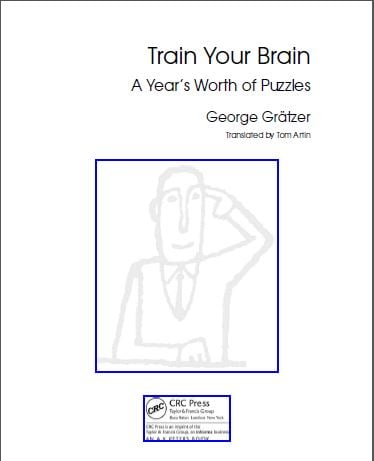
Train Your Brain A Year's Worth of Puzzles
Most people to whom I present this puzzle ask me to repeat it, to give
them a chance to pull themselves together, or maybe change the subject.
Some say confidently, “It was Jack’s mother who called him, right?” And
then I have to argue that this is wrong. It occurs only to a few of them to
examine their answer and perhaps reach that high peak from which one
doesn’t just guess, but solves the problem through logical thinking.
And really, the answer is quite simple. (It helps to draw little circles
on a paper to diagram the people and then lines between the circles to
describe their relationships.) The mother-in-law of the caller’s mother is
Jack’s mother; in other words, the husband of the caller’s mother and Jack
are children of the same mother. But since Jack has no siblings, the hus-
band of the caller’s mother is none other than Jack himself. That is, Jack
is the husband of the caller’s mother, and thus the caller is Jack’s child (or
perhaps, his wife’s child).
Everybody is astonished: the caller, since the father hasn’t recognized
his child’s voice, and the reader, seeing how simple the solution of such a
puzzle can be.
“Really, even I could have solved that,” you might say—and you would
be correct. Try out the brain teasers in this book, and you’ll see that you
can solve them too.
What are the prerequisites for solving brain teasers?
First, you need to have good ones! Please browse through the book. I
hope that even a picky reader will find ample material to his or her taste.
Preface xvii
Second, you have to be committed to thinking logically. You have to
think attentively and systematically through what you know, and then
consider what conclusions can be drawn from it. This is not in and of itself
a prescription for solving problems (no such prescription unfortunately—
or thank God—exists), but rather it is a basic observation.
Third, you need an idea. Actually, not every brain teaser requires this.
The problem just presented, for instance, unraveled itself, as it were, after
a bit of logical reflection and without any brilliant ideas. With many brain
teasers, however, you have to step a bit “outside the box,” become mental
“innovators.” At first, of course, you require only modest ideas. But later,
in proportion with the level of difficulty, the pleasure you feel at finding a
good idea is correspondingly greater.
I have yet to find among my friends anyone who, when reading a book,
is able to stick to the principles and instructions of the preface. Neverthe-
less, I would like to offer such advice. The reader can make use of it as he
or she likes. Cheers!
As the reader will perhaps have noticed, this book is not organized
into chapters, but into 52 weeks. I’ve organized the book this way so that
the reader will find intellectual treats for every week of a year. The fact
that each week presents only a few such treats (in the first 36 weeks, three
per week; in the last 16 weeks, only two per week), counsels patience.
Take your time solving the problems. Don’t run headlong to the so-
lution, and don’t pass the problem over lightly either, just because you
think, “I’m not going to be able to solve this.” Sure you will. You’ll man-
age if you persist.
If you don’t solve the problems in the order in which they are pre-
sented, it can well happen that you run into unfamiliar concepts. So I
recommend that you solve the puzzles in order. Also, you should always
look at the solution presented in the book, even when you solve the prob-
lem independently. Often, the solution we give introduces concepts you
will need later on or presents general principles that can be profitably put
to use in problems that come later. Also, if necessary, consult Section 1 of
the Appendix, p. 221, surveying the terminology we use.
If after several attempts, you are still unsuccessful in solving a brain
teaser (after repeatedly trying and reflecting on it for, let’s say, three or
four days), you should first look at the hints in the second part of the
book. There you will find ideas for solutions to a number of problems.
These are not complete solutions, which are given in the third part, Solu-
tions. In Hints, you may also find references to earlier problems—where
needed. The little “Hint-Man” greeting the reader in the margin indicates
that there are ideas and concepts for the solution in Hints.
A separate title designates the last sixteen weeks: Black Belt. In this
part, we pose only two brain teasers per week, but if you manage two
xviii Preface
such puzzles, you can give yourself a pat on the back. I recommend this
section to all who get a kick out of experiencing beautiful ideas.
Off we go! Readers and solvers, he who seeks, finds. Look for the
solution and find salvation! Have fun with it. Train Your Brain. Now it’s
time for our weekly brain teasers!
 Cart
Cart  Checkout
Checkout